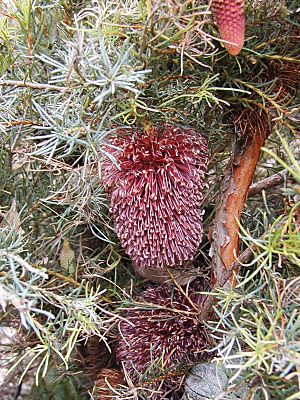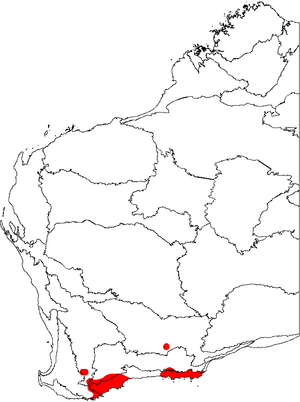Nodding banksia facts for kids
Quick facts for kids Nodding banksia |
|
|---|---|
 |
|
| Banksia nutans nutans | |
| Scientific classification | |
| Kingdom: | |
| (unranked): | |
| (unranked): | |
| Order: | |
| Family: | |
| Genus: | |
| Species: |
B. nutans
|
| Binomial name | |
| Banksia nutans |
|
The Nodding Banksia (Banksia nutans) is a unique shrub found along the south coast of Western Australia. It gets its name because its flowers hang downwards, unlike most other banksias that have upright flower spikes.
This plant usually grows to about one metre (3 feet) tall. It has pretty pale blue-green leaves that are very fine. Its flowers are a cool purple-brown colour. A famous botanist named Robert Brown first described this plant in the early 1800s.
The Nodding Banksia is not often grown in gardens. It grows best in places with a Mediterranean climate, which means warm, dry summers and mild, wet winters. However, it doesn't do well in humid summer climates, like Sydney, because it's sensitive to a plant disease called dieback.
Contents
What the Nodding Banksia Looks Like
This shrub grows up to one metre (about 3 feet) tall. It has bark that peels off in thin red and grey flakes. Unlike some other plants, it doesn't have a special woody base called a lignotuber that helps it regrow after a fire.
Its leaves are long and thin, usually between 10 and 20 centimetres (4-8 inches) long. The flowers start as pinkish-purple buds. When they open, they turn a purplish-brown colour and surprisingly smell like onions!
The flower spikes are about four to seven centimetres (1.5-3 inches) long. What makes them special is that they hang down instead of standing up. After the flowers fade, they stay on the plant, making the seed pods look a bit hairy.
How Scientists Group the Nodding Banksia
Discovery and Naming
The Nodding Banksia was first found by Robert Brown on January 1, 1802, in Lucky Bay, Australia. He named it "Banksia nutans" right away. Brown officially published his description of the species in 1810.
Different Types of Nodding Banksia
There are two main types, or varieties, of the Nodding Banksia:
- B. nutans var. nutans: This is the original type of the plant.
- B. nutans var. cernuella: This variety was identified in 1981 by a botanist named Alex George. It has slightly smaller flowers and seed pods than the other type. Its seed pods are usually smooth, while those of B. nutans var. nutans tend to be wrinkled.
Where it Fits in the Banksia Family Tree
Scientists like to group plants to understand how they are related. The Nodding Banksia belongs to the Banksia genus. Over the years, different botanists have placed it in various groups within the Banksia family.
For a long time, it was grouped with other banksias that have hooked styles (part of the flower). More recently, DNA studies have shown that the Nodding Banksia might be related to different groups than previously thought. Scientists are still working on the best way to classify all the banksias!
Where the Nodding Banksia Grows
The Nodding Banksia grows along the southern coast of Western Australia. You can find it between the towns of Albany and Cape Pasley. There are two main areas where it grows a lot: one near Albany and Hopetoun, and another between Scaddan and Cape Pasley.
This plant likes to grow in low areas, especially among coastal sand dunes. It prefers white or grey sand, or sometimes gravel. Most of these plants are found in a region called the Esperance Plains. This area has a warm mediterranean climate and is covered mostly by mallee-heath and other scrubby plants.
Life Cycle and Ecology
The Nodding Banksia does not have a lignotuber (a woody swelling at the base that helps some plants regrow after fire). This means that fire kills the plant. However, fire also helps the plant by making its seed pods open and release seeds. This allows new plants to grow and the population to recover well after a fire. The seeds don't need any special treatment to sprout, and they usually germinate within 17 to 54 days.
A study in the Fitzgerald River National Park found that the Nodding Banksia is an important food source for the honey possum (Tarsipes rostratus) during the summer. Honey possums love to drink the nectar from its flowers.
Scientists have also looked at how climate change might affect this plant. They predict that the area where the Nodding Banksia can grow might shrink by 30% to 80% by the year 2080, depending on how much the climate changes.


